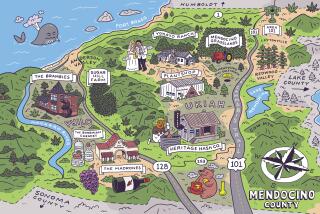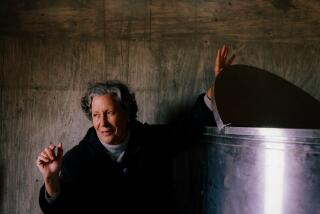A Single-Minded Purist With a Passionate Goal for Amador County
PLYMOUTH, Calif. — There is more, much more, to Scott Harvey than meets the eye or the taste buds.
But finding out about Scott and his Santino Winery and his passion for wine from his earth, one must trek out east of Sacramento to this hilly gold country region where the original forty-niners cut through the land looking for treasure.
This is the Shenandoah Valley in Amador County, recognized for the last decade or more as a grand place to grow Zinfandel grapes for red wines.
Santino is one of two dozen wineries dotting the Sierra foothills and it is one of the few in the region dedicated to preserving the wine heritage of the region by pursuing only the local grape varieties, those that historically have done well in this deep soil.
To be more precise, that means that Harvey is more the serf; the vine is master. He won’t, for example, play the “wine-upsmanship” game so many California wineries play with Chardonnay, making one with more oak, more alcohol, more extract.
Harvey makes no Chardonnay at all.
Nor will he play the bigger-is-better game with Cabernet Sauvignon.
He makes no Cabernet.
It is Amador he worries about, not grape varieties, so he makes Zinfandel and Barbera and a light Muscat and he’s messing around with the Rhone varieties such as Syrah, Grenache and Mourvedre. And he makes excellent White Zinfandel, and a rose now and again.
In addition, because of his training, he makes some of the state’s most exquisite dessert wines from traditional grape varieties as well as a couple of late-harvest wines from varieties you’d never guess.
What else is marvelous about Harvey is that he is so blunt about his passion.
“I’m scared to death that Amador may become another Hecker Pass area,” he says, referring to the wine growing region near Gilroy, south of San Francisco, that once was home to some superb red wine varieties growing on ancient vines.
Harvey says that today Hecker Pass has few purists willing to continue tradition by making blended wines from the old vines.
He’s upset, for instance, that tasting rooms in so many historic wine regions feature signs for the wineries’ latest Chardonnays, even though the soil never was used for Chardonnay in the past.
“My goal for Amador County is to see regional wine being made,” Harvey said. He said he is encouraging local wineries to put out a red wine blended from the best grapes on the property.
He envisions a label that says, simply, “Amador,” with the name of each winery on the bottom. The winery’s name would be the crest by which the consumer would know the wine over various vintages. And the blends would be those chosen by each wine maker as befitting the soil he or she has.
If Harvey sounds like a leader of the local wineries, he is. He was reared here, an A student in high school here, as well as student body president. And he led the drive to get local approval three years ago of a proprietary Amador bottle, with the county’s name embedded in the glass.
Harvey admits that Amador is a warm growing region, but not so warm that great wine can’t be made here. But great wine must be done with a sense of what the vines desire.
“In a warm growing region such as this, the best red wine is almost always a blended product,” he said. “Barbera has the acidity and the backbone, and Zinfandel has the briar-y fruitiness.”
He pointed to his own line of wines that includes three Zinfandels, each of which has Barbera in it, and a Barbera that (of course) has a dose of Zinfandel.
But talking about the wines of Santino without a sip does little good because of the uniqueness of them, and sipping them without a discourse on the man behind them is equally frustrating because of his single-minded dedication.
For instance, at a time when other wineries are releasing their 1987 or even 1988 Zinfandels, Harvey has just released his 1985s. “They need bottle age,” he says, and I can attest to that. I have tasted them young and love them, but as good as they taste at that stage, the astringency in them is hard to bear unless tasted with food and with a certain generosity of spirit.
Time is the best cure to the astringency, said Harvey.
His 1985 Amador Zinfandel ($7) has a spice and tar aroma, but it is lighter and more accessible now than it was a couple of years ago. A very good value. The 1985 Fiddletown Zinfandel ($9) has a raspberry, pepper, and earth tone to it that demands to be decanted so the aromas can blend with air, and more time will make it more intriguing.
And the 1986 Grandpere Zinfandel, from vines reportedly planted some 120 years ago and never replanted, is among the surprise wines because of the interesting coffee, tobacco, chocolate, black cherry and burnt cedar aromas that waft out of the glass. Yet over time, this wine too will be more giving than it now is.
As we toured the 16-acre Santino property in Scott’s 1928 Model A Ford that he restored, with his mutt Bacchus underfoot, I could see dense, rich, fertile soils on gently rolling slopes ringed with early season flowers. It is this rich soil that gives vigor to the old vines that, by rights, should long ago have died.
This is the heritage Scott wants to preserve, and particularly he is keen to keep vital the Grandpere Vineyard that he and his wife, Terri, acquired in 1984. It’s a 10-acre parcel that makes superb wine.
Harvey is unique in many ways. For instance, because the winery is successful, and because he is a part (5%) owner, he experiments beyond what any mortal wine maker could envision let alone try. And some of what he does, he admits, is “Amador magic,” and some of his trade secrets border legality.
“Say a Zin needs to be 40% Barbera to be better wine,” he says. “Well, the law limits me to 25% Barbera or I can’t call it Zinfandel,” so he has developed ways of making the wine legal yet still having the character of Barbera. Trade secret.
Some of his other tricks of the trade are well known in Germany but little known here.
After leaving high school, Harvey was an exchange student in Germany (where he was born to American parents) and there began his formal wine education. Years later, after stints working nearby at Story Vineyard and Montevina--and after gleaning blending tricks from former Montevina wine maker Cary Gott (now at the Monterey Vineyard)--Harvey went to Santino.
Even though he had never been a head wine maker any place else, he won his first major battle at Santino in 1979. The owner of the winery at the time had designed a rather plain label. “I said that every wine I made at Santino would have my name on the label or I wouldn’t take the job,” he said. “It was the best decision I ever made.”
He feels that if a wine maker made the wine, he should be responsible for it, which encourages more diligence.
Harvey’s greatest accomplishment, perhaps, and certainly the one that gives him the most accolades, are his late harvest wines, which amaze even visiting German wine makers with their concentration and quality.
These very sweet wines often bore me because high sugar must be balanced by high acid, and few wine makers have the courage to make these wines with the acidity they need. Harvey doesn’t shy away from acid no matter what the statistical sheets say.
Thus when I tasted his absolutely stunning 1986 Riesling designated Dry Berry Select I was awed by its peach/pear aroma and its amazing balance. The wine has 22% residual sugar, making it a TBA to German wine lovers, but with acid above 1.1% the wine is anything but cloying.
Moreover, the 1988 Frost Wine, a pale Zinfandel made from (intentionally) frozen grapes has an aroma of plum pudding and a taste so luscious you can’t believe you’re tasting wine. It’s ambrosia.
The Riesling is $18 a half bottle and the Frost wine is $14 a half bottle, expensive to be sure, but worth every cent.
There’s lots more to be said, both about Harvey and Amador County, and another column soon will deal with the wonders of this undiscovered mecca for red wine fanciers.
Wine of the Week: 1987 Baldinelli Zinfandel ($8)--To show how Zinfandel can taste with less time in the bottle, try the Santino with this younger Amador County wine. It has marvelous Amador-ish fruit and a lush mouth feel despite a tannin structure that. . . (incomplete sentence.)
More to Read
Eat your way across L.A.
Get our weekly Tasting Notes newsletter for reviews, news and more.
You may occasionally receive promotional content from the Los Angeles Times.










